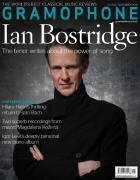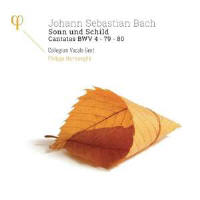Texte paru dans: / Appeared in: |
|
|
Outil de traduction (Très approximatif) |
|
|
Reviewer:
Jonathan Freeman‑Attwood ‘God the Lord is Sun and Shield’ – the title of Cantata No 79 – is the epithet given to a trio of Luther-inspired works continuing Philippe Herreweghe’s patient and thoughtful series of themed cantatas, which started with Virgin Classics in the late 1980s, followed by the bulk with Harmonia Mundi and the latest cache on Herreweghe’s own label, PHI. Collegium Vocale Gent’s distinctive approach to conveying the ‘Word’ has underpinned many deeply satisfying cantata performances over the years, their litany of conceits projected with a degree of restraint, even occasional asceticism, but always profoundly elegant. Yet, as we hear so convincingly in three of Bach’s most celebrated and ambitious works, any corrective inclinations over excess are balanced by beautifully judged palates of fresh, open expression. Ein feste Burg is a case in point: no hammering out of Luther’s 95 theses here but an affirmative and calculated evolution of the building blocks of faith which then find greater meaning in the way Herreweghe patiently curates a convincing journey towards the longed-for Kingdom. Delectable pacing and organic contrast in the arias represent the keys to the heart of the work, as do the soloists. Veteran Bachian Peter Kooij is less convincing than of old but still a seasoned interpreter, but the highlight is ‘Wie selig’ – that unfailingly entrancing duet – which Alex Potter and Thomas Hobbs sing with unerring tenderness. Any disc with Christ lag in Todesbanden raises the stakes before a note is heard. If there is a Bach equivalent of Mozart’s Piano Concerto in E flat, K271, where every attribute seems faultlessly assembled, then this is it. Both were 21. Not surprisingly, Herreweghe follows a concentrated course of interiority, chiselling out meaning from Bach’s irrepressible imagery with each ‘versus’. The third verse duet is utterly beguiling with its exhausted sighs on ‘Tod’ (‘death’), the emergence of the doubling cornett a masterstroke in its glow of promise of salvation. If Herreweghe coaxes us towards the reflective 17th-century vocal concerto in his reading of Cantata No 4 – especially in how the various vocal and instrumental dialogues offer true rhetorical insight – then in the chorus of No 79 he thrusts us into the elegant 18th-century world of the modern Italian concerto and a display of intensely spun contrapuntal pyrotechnics of Bach at his absolute peak in 1725. Bach knew this was a corker because he returned to it for his compendium of four short Lutheran Masses a decade later. It’s a kind of return for Herreweghe, too, as his performance of those Masses has always shone with a special brightness. Despite a few rough edges (some talking can be heard at the beginning of the fourth movement of Cantata No 80), deeply satisfying insights abound in each of these masterpieces. |
|




